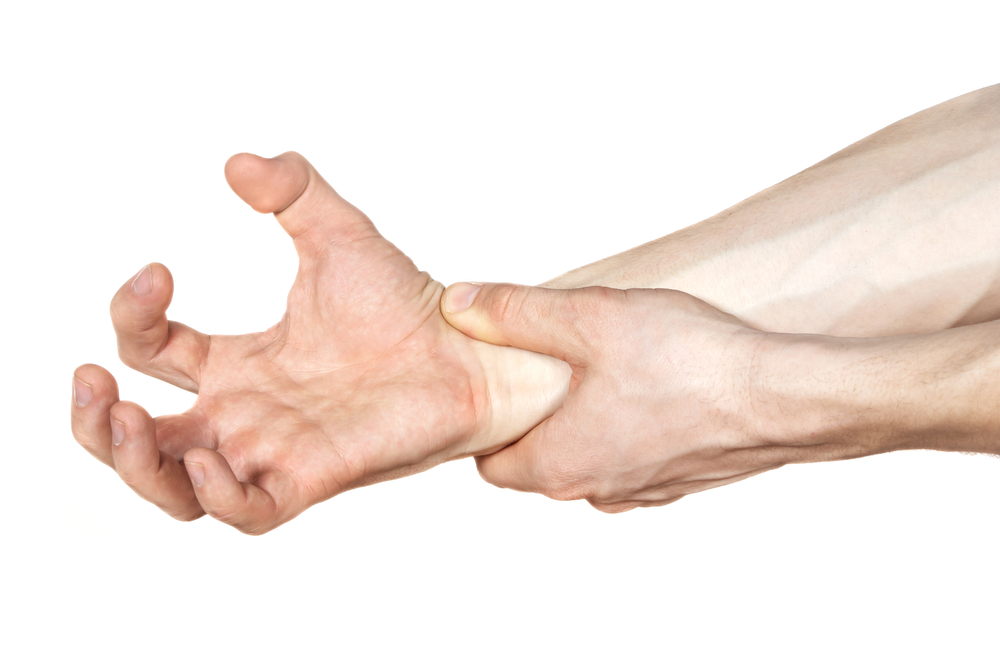Hand cramps and spasms can come on at any time, causing pain especially when they last for more than a few seconds. They can be caused by several conditions or just happen out of the blue for seemingly no reason at all. If you’ve experienced a time where it’s hard to move your fingers or open up your hand then you know exactly what we are talking about.
Learning more about hand cramps can help you avoid them in the future, understand their causes, and treat them more effectively. You shouldn’t have to live with hand cramps that interfere with your life. Read on to learn more and stop those cramps in their tracks.
All About Muscle Contraction
Muscle contraction is a complex system that involves the brain, muscles, nerves, and spinal cord. “Certain chemicals and proteins are also involved in normal muscle contraction and are responsible for the shortening and relaxation of muscle fibers,” says Medical News Today. With a signal from the brain, muscles contract and proteins and chemicals move in and out of the cells. When something is not quite right, cramping and muscle spasms can happen.
The spasm is the muscle repeatedly contracting and releasing or just contracting and maintaining a sense of tightness. These episodes of cramping and spasming are generally short lived. When they last more than a few moments they can be very painful.
Symptoms
The symptoms of hand cramps will vary in severity and duration for every individual. The cramping can range from a slight nuisance to extremely painful. Sufferers can also experience tingling and burning sensations in their hands. The cause of the cramp can be one or more of several things. Electrolyte imbalance, overuse, dehydration, or one of the many chronic conditions that cause cramping.
One of the best ways to determine the cause of your symptoms is to keep track of them. Use a journal or notebook and write down when they occur and what was going on right beforehand. You might see a trend that evolves overtime to give you an idea of the cause.
Overuse
Hand cramping caused by overuse is common, especially among writers. Sometimes called a writer’s cramp, overuse places excess strain on your hand. When you are grasping something for a long time the constant stress on your muscles can cause you to have a painful hand cramp.
Overuse hand cramps aren’t exclusive to writers. They can occur in anyone but especially musicians, painters, plumbers, and carpenters. Any movement that requires a tight grip on something can increase your risk of an overuse hand cramp. To treat this type of cramp, give your hand frequent breaks and change the grip size of whatever it is you’re holding.
Electrolyte Abnormalities
Calcium, potassium, sodium, and magnesium. This group of chemicals is called electrolytes. “Electrolytes are substances within the body, which are responsible for maintaining normal bodily functions, such as nerve and muscle activity, hydration, blood pH, blood pressure, and tissue repair” reports Medical News Today. When one or more of these electrolytes is out of balance it can lead to a slew of problems, including hand cramps.
Electrolyte imbalances can be caused by multiple factors. Some include dehydration, certain medications, kidney disease, excessive vomiting, and strenuous exercise in the heat. Treating an electrolyte imbalance will be dependent on the severity of the imbalance and the cause. Electrolyte changes can be life threatening, so never hesitate to reach out to your doctor for further guidance.
Carpal Tunnel Spasm
Carpal tunnel syndrome is a condition where the median nerve becomes compressed in the wrist. It results in hand weakness, pain, numbness, and tingling sensations. Along with this condition comes carpal tunnel spasms. Harvard Medical School says “If you experience spasms in other areas of your body, such as the upper arm, neck, or face, this could indicate a more serious neurologic cause, although this relatively rare.”
You can help reduce carpal tunnel spasms by making sure you are well hydrated and stretching your fingers regularly says the source. Other ways to treat carpal tunnel is by reducing the swelling around the median nerve with anti-inflammatory medications or steroid injections. Talk to your doctor to determine the best treatment for you.
Diabetic Stiff Hand Syndrome
Hand cramps are not only painful but they can seriously interfere with your regular daily activities. If you have type 1 or type 2 diabetes you are at an increased risk of a condition called diabetic stiff hand syndrome. According to Medical News Today, “this condition limits finger movement due to the hands becoming waxy and thick.” The cramping with this condition is not necessarily a muscle cramp but just a change in the hands that makes moving difficult.
People with this condition may also experience weak hand joints, decreased hand function, waxy skin on the back of the hand that makes the skin tight. The source notes that “controlling blood sugar levels may prevent a person with diabetes from developing diabetic stiff hand syndrome.” If you have developed the condition try hand stretches, exercises, and physical therapy to improve the stiffness.
Rheumatoid Arthritis
Rheumatoid arthritis (RA) is an inflammatory condition where the body attacks the joints and other areas of the body. It can cause joint pain, stiffness, swelling, and weakness. Hand cramps are also common in people with rheumatoid arthritis.
Dr. Weselman from Everyday Health reports that “inflammation of the joints and tendons in adjacent muscles can affect muscle function, making RA patients more prone to muscle cramps.” On top of that, the joint stiffness can feel like a hand cramp, making it tricky to know what you are actually experiencing. There are several treatment options for people with RA. Medications, heating pads, and exercise to name a few. Always follow your doctor’s advice when starting a new treatment.
Carpopedal Spasm
One of the lesser known reasons you could be experiencing hand cramps is from something called a carpopedal spasm. This type of muscle spasm is caused by hyperventilation. When you hyperventilate you are lowering your body’s carbon dioxide levels which can cause the calcium level within your blood to decrease. The result is a hand (or less commonly a foot) cramp.
Hyperventilation happens when you breathe faster and more deeply. People who have anxiety might experience this or it can happen just from a hard, long cry session. The easiest way to stop a carpopedal spasm is to slow down your breathing. This can be easier said than done. Talk to your doctor if you are experiencing hyperventilation episodes.
Treatment: Avoid Dehydration
One of the best ways to treat hand cramps is to stay well hydrated. When you become dehydrated your body doesn’t function properly, with one of the resulting problems being cramps. Being in hot temperatures can exacerbate dehydration and needs to be taken into account.
According to the Mayo Clinic, women should drink 11.5-cups of water a day and men should drink 15.5-cups of water a day. Your total water goals will vary based on how much you exercise, your environment, health, and if you are pregnant or breastfeeding. The best way to know if you are drinking enough is if you don’t feel thirsty and your urine is light yellow to clear.
Treatment: Stretch Regularly
When you have been writing, typing, or doing any type of work that puts extra stress on your hands then stretching might be a good way to treat those painful cramps that pop up. Stretching can release muscle tension in your hands to relieve painful cramps. As soon as you start feeling a cramp come on stop what you’re doing and gently pull back on your fingers and thumbs to see if that helps.
Regular hand and wrist stretching can be a great way to prevent cramps from even happening. They are especially effective in people with carpal tunnel syndrome. If your stretching routine isn’t cutting it, reach out to a physical therapist or doctor for specific stretches that target the areas you need.
Treatment: Treat Underlying Causes
Hand cramps can be episodic and occur for seemingly no reason at all. Other times they can be caused by chronic conditions or diseases. If you are in the latter group then it’s time to treat those underlying conditions to prevent your hand cramps. Some underlying conditions can be diabetes, carpal tunnel syndrome, nerve disease, and rheumatoid arthritis.
It’s best to talk to your doctor if you have a chronic condition that is also causing hand cramping. They will be able to guide you through a treatment plan catered to your needs. Getting your underlying conditions under control will likely improve multiple areas of your life. Not just your hands!
Treatment: Take Frequent Breaks
Oftentimes hand cramps are caused by overuse. When this is the case the best remedy is to give your hands frequent breaks. It’ll give your hands a much needed rest and let them recover from the stress and strain of constant movement.
If you find that you have a hard time remembering to give your hands a break set a timer on your phone, watch, or whatever else you have nearby. Even a couple of minutes an hour can make a huge difference. If frequent breaks aren’t enough to stop your hand cramps then the cause might be something other than overuse. Make sure you are well hydrated and consider reaching out to your doctor for other solutions.















